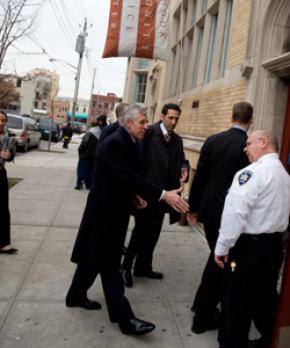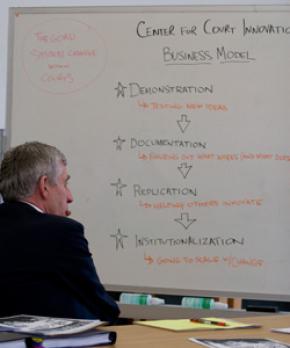


Jack Straw endorses court-community collaboration following a February 2008 visit to the Red Hook Community Justice Center.
Following a visit to the Red Hook Community Justice Center —during which he experienced a judge’s-eye view of the courtroom, quizzed staff about operations, and met with a group of ex-offenders who had gotten their lives back on track—Jack Straw, the United Kingdom’s justice secretary and lord chancellor, endorsed efforts in his own country to foster court-community collaborations. (To hear a podcast reporting on Straw's visit, click here.)
In an opinion article in the Guardian published after his visit, Straw wrote that the Red Hook Community Justice Center “has done much to increase people’s confidence in criminal justice.”
“We should not be so proud that we are unable to learn lessons from others. In New York, they have recognized that the courts cannot do it alone. Without the cooperation of the community, many offenders simply repeat the cycle of offending and detention,” Straw wrote.
Earlier visits to the Justice Center by British officials inspired the creation in 2005 of the North Liverpool Community Justice Centre. The North Liverpool pilot has been followed by 12 other community court projects across England and Wales. “The reputation of Red Hook has gone far and wide,” Straw said.
Straw had a chance to sit on the bench with presiding Judge Alex Calabrese. Among the cases Calabrese heard was that of a woman with a long history of drug abuse and prostitution arrests. Calabrese had ordered her to participate in drug treatment. “It seems like everything is going really well. You should be proud,” Calabrese told her after reviewing a positive report from the drug-treatment facility. At the conclusion of her appearance, the courtroom erupted in applause and both Calabrese and Straw shook her hand.
During a tour of the building, Straw queried both staff and clients about their experiences at the justice center. Later, Straw met with ex-offenders and the Justice Center’s law enforcement partners, including 76th Precinct Captain Michael Kemper, who explained how the police and the Justice Center have worked together to tackle low-level crime and improve safety. The 76th Precinct is the safest in Brooklyn according to the latest crime statistics.
Straw also met Tina, a former offender, who explained that she’d lived on the street for nine years before an arrest brought her to the justice center. Judge Calabrese mandated her to a year of treatment. “And I was just so relieved,” Tina said. “I never looked back. I stayed in the program three years because that’s what it took … and now I work for them.”
Virtually every week, the Center for Court Innovation hosts visitors from around the U.S. and the world -- criminal justice officials from more than 50 countries have toured the Center's demonstration projects. Last year, the Center for Court Innovation hosted more than 700 visitors. “During these visits, we try to show that courts can work better and that outcomes matter. We’re demonstrating that combining punishment and help is the best way of getting clients back on track, reducing recidivism, and serving the community,” said Julius Lang, who oversees the Center's community court technical assistance efforts.

